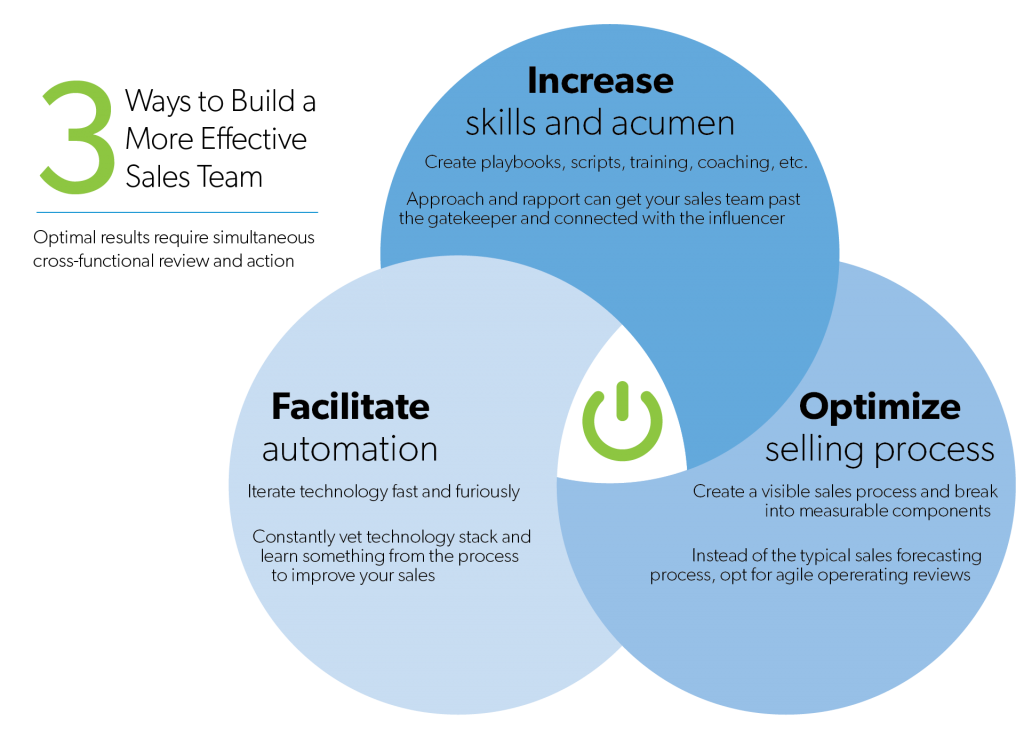We’ve worked with companies from all over to help them optimize their business processes. Most recently, we’ve been advising on the art and science of optimizing sales and consulting on a variety of projects, helping implement processes that contribute to business success. And what we’ve discovered is that change and innovation are necessary elements when it comes to your sales process.
If you want your sales folks to be more effective, there are really only three ways to accomplish this:
- Increase their skills and acumen through instructional design or training
- Optimize the process by which they sell (i.e., decreasing administrative tasks, so they focus on actual selling)
- Deploy sales enablement technologies or better information to facilitate automation
You probably have your own people providing support in each of these three areas. However, these teams tend to work separately from each other. When looking at a sales mission, you need to examine it through all three of these lenses, simultaneously. You want to pull all three levers—at the same time—for the optimal result to drive efficiency.

Building Essential Skills
Sales people require playbooks, scripts, training, coaching, etc. to be effective at selling. Consider the cold-calling process. Companies usually employ a gatekeeper to weed out most sales calls. You have to teach your sales team how to develop relationships and say just the right thing. It’s all about the approach and rapport building when it comes to getting past the gatekeeper and connecting with the influencer.
Instructional designers create training materials, managers offer coaching, and marketing puts together a playbook. But to enable your sales people to truly be effective, instructional designers, business process engineers, and technologists need to be on the same team constructing the process by which to teach these skills. They need to all be a part of the creation, so they can see what is working, what needs to be tweaked, and what might just need to be scrapped.
Creating the Process
To be successful, there have to be process models built. The sales process needs to be visible. With this new team of instructional designers, business process engineers, and technologists, look at the goals and objectives of your sales teams and the processes they perform to achieve those, then break those down into measurable components.
If you use a customer relationship management (CRM) system (which you should), these steps or a workflow needs to be built into it. Your CRM tool should instruct the sales team on what to do next, rather than looking back on what was done. If your team is following the process, the results will follow.
Forego the typical sales forecasting process of simply reading over the current pipeline report, and instead, opt for agile operating reviews, which are decision-making meetings with clear actions to impact business results. In a recent article, Sales Benchmark Index’s Matt Sharrers discusses this more fluid approach and explains how it works. Sales objectives need to align with corporate objectives. Sales operations can ensure that alignment remains consistent.
As Matt describes, sales operations (sales ops) is quickly becoming an important and strategic asset inside the mid-to-enterprise sales organization. Much more than data and analytics, sales ops is the study of pipeline management and the key indicator of how your organization’s sales process is performing at time-to-close rate, average opportunity value, and performance to forecast.
Using Technology Successfully
Technology is not a one-size-fits-all mentality. Iterate fast and furiously. The team should put a process in place where technologies are constantly being vetted and use cases are being developed. If a technology isn’t working, why isn’t it working? Is it the tool or are you using it ineffectively? Regardless of success, learn something from the vetting process to improve your sales.
Immediate Results
Developing and deploying a sales process that produces winning results is not a quick and easy undertaking. It’s also not an event. It’s a continual process that requires a combination of art and science, which includes creative thinking, collaboration, and continuous process improvement. Most companies struggle reacting to change. However, it’s not about reacting to change, it’s about forcing change to produce the desired results.
Let Us Assist
Let us determine the appropriate strategy for your company via a MarketSource assessment. MarketSource sales experts will work with you to define your challenges and design a turnkey solution that produces results in the areas of gaining new customers, launching new products, growing market share, optimizing sales expense or maximizing a mature product.
Our sales teams deliver more than $6 billion in revenue for many of the most iconic brands in the world and a diverse mix of forward-thinking small- and medium-sized businesses. You can learn more about this topic and MarketSource’s proprietary process, empowered people and proven performance by contacting us today.

